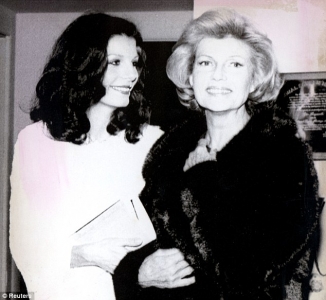Article by Princess Yasmin Aga Khan, president of Alzheimer's Disease International on her mother Rita Hayworth
We Didn't Know Then
What We Know Now"
By Princess Yasmin Aga Khan, president of Alzheimer's Disease International, honorary vice chairman of the national board of the Alzheimer's Association and general chair of the Alzheimer's Association Rita Hayworth Galas
My mother, Rita Hayworth, was the most beautiful and glamorous movie star of the 1940s and 1950s. She spent much of her life memorizing complicated dance routines and movie scripts. How ironic that she would later be diagnosed with Alzheimer's disease.
As a young girl on visits home from boarding school, I would notice her odd behavior. She would move her personal items from her bedroom to other closets around the house, including mine. She would throw all the food out of the cupboards.
She would imagine voices outside and thought someone was trying to break into her home. The police would have to come and tell her no one was there. I remember the many times she would call me at college and ask me the same questions over and over again.
As the disease progressed, her confusion, disorientation and fear worsened. She was unable to remember what day it was or even the name of our president. Her panic increased, and my own fear and sense of helplessness and guilt became overwhelming. It was a terrible day when we stood together in front of a mirror, and she turned to me and asked, "Who are you?"
It wasn't until she had a complete breakdown that I could step in and take charge of my dear mother's life. I became her caregiver, and I worried about her all the time.
My thought back then was, "What on earth is going on? What's happening to her?" Today, she would be diagnosed with younger-onset Alzheimer's disease, since she was only in her 50s. But this was the 1970s. We didn't know then what we know now. Very few people had heard of Alzheimer's disease, and it was often misdiagnosed. Patients would be over-medicated and some even sent to mental institutions.
The best anyone could come up with was that she was suffering from alcoholic dementia. She did like to drink, but it wasn't that much, and I now believe that alcohol helped her cope with the knowledge that she was losing her memory and, ultimately, her career as well.
At last, in 1981, thanks to Dr. Ronald Fieve—with the help of a CAT scan and memory test—we got the right diagnosis. I felt such a great sense of relief knowing exactly what was wrong. Alzheimer's can be an embarrassing and humiliating disease not just to people who have it but to friends and family as well, and early diagnosis by a neurologist is key to coping.
With the word of my mother's illness getting out, I was approached by the Alzheimer's Association, which had recently been started by Chicago businessman Jerome Stone, whose wife had the disease. This organization was my savior. At that time, the Alzheimer's Association was a small mom-and-pop group made up of husbands, wives, sons and daughters who had family members with the disease. All these wonderful people were my support group. We were there for each other. We shared our daily knowledge and experience of how to best care for our loved ones.
We sprung into action. We went to Washington to push for federal funding for Alzheimer's research, because there was very little money spent on the disease at the time. We raised dollars to award to young researchers doing work in the field.
We developed Alzheimer's Association chapters around the country to support caregivers and make sure they knew that they were not alone. We participated in the development of Alzheimer's Disease International (ADI), of which there are presently 72 member countries.
We continue our efforts today, pressing for heightened public awareness, increased government engagement, more research dollars, programs providing respite for caregivers and financial relief for those who cannot afford home care attendants and costly nursing homes.
My mother passed away in 1987. We have come a very long way since then. But there is so much more work still to be done.
- 10335 reads
 Ismaili.NET - Heritage F.I.E.L.D.
Ismaili.NET - Heritage F.I.E.L.D.